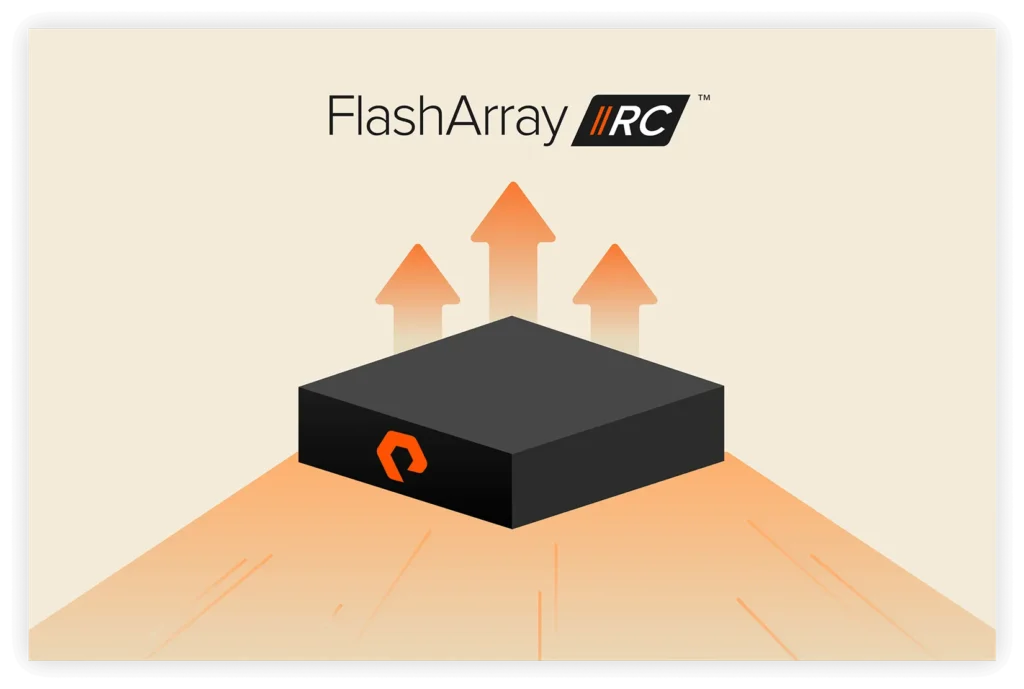A few years ago, my wife and I relocated to a suburb of Atlanta. We quickly learned a lot about the region’s well-known southern hospitality. But it wasn’t long before we heard people saying, “bless their heart.” It’s a phrase you use when you “want to be sweet but don’t want to act ugly.” It also works to express several types of feelings toward another person¹. Here, we will talk about Dell’s PowerStore conundrum and what that means.
After watching recent presentations from Dell on the PowerStore 2.0 launch, I couldn’t help but think, “bless their heart.”
Dell has a conundrum on its hands.
Let’s go back in time a bit. In the early 1990s, it was popular to use a network to connect large storage arrays utilizing dozens of hard disks to a mainframe. The Symmetrix product helped propel EMC to a multi-billion dollar company². Later, the industry started utilizing storage-area networks (SANs). Later generations of Symmetrix were even bigger and supported more drives with more capacity, more data features, and better resiliency.
Other vendors brought storage products to market touting “enterprise class” with better features and resiliency. HP even shot its array with a .308 caliber M80 bullet to “prove” that it would still run³. (It was actually Hitachi’s array sold through an OEM4.)
The enterprise storage war was in full swing.
Along Comes Mid-Range Storage
Fast forward a few years to the late 1990s and early 2000s. Data storage needs started to skyrocket. Organizations of all sizes were generating data that they needed to store on centralized, highly available platforms. Then, in 2003, VMware released server virtualization with an awesome feature called “VMotion” that improved resiliency and flexibility. At the time, it seemed like too-good-to-be-true-fairy dust. The main ingredient of that fairy dust was shared storage.
Now, everyone wanted shared storage with high availability and a variety of data-service features. But most couldn’t afford the refrigerator-sized arrays or even the arrays created to challenge the larger behemoths (Data General CLARiiON, for example). That’s when smaller “mid-range” storage arrays emerged with less hardware, fewer space requirements, and a stripped-down feature set. To gain mid-range market share, vendors created (or acquired) smaller arrays with fewer features and less availability.
I believe EMC foresaw the popularity of the mid-range market, and possibly virtualization as well. EMC purchased Data General in 19995 to use CLARiiON as its entry into that market. This positioned EMC Symmetrix for the enterprise and CLARiiON as a mid-range offering. The names have changed several times, but EMC still has the two options.
- Symmetrix became DMX, which evolved into VMAX, and is now PowerMax6.
- CLARiiON became Unity, then Unity XT7 and is now PowerStore8, for the “mid-range9.”
And that, bless their heart, is Dell’s conundrum. Dell has continued EMC’s trend of utilizing separate products to address two separate markets created in the 1990s and early 2000s.
Enterprise Storage for All
My question: Why choose your storage based on a designation created more than 20 years ago?
If a storage array can provide the level of performance, features, and availability that large organizations need—but do it within the budget of all companies—wouldn’t that enable enterprise storage for all?
It’s interesting if we look at how the public-cloud providers provide storage services. They don’t designate enterprise vs. mid-range. They typically provide storage based on access method10 while providing the same features and availability regardless of the solution picked. We believe that is what we have done with Pure FlashArray//X and FlashArray//C.
Let’s dive in a bit further to the “enterprise” concept to see how Pure Storage FlashArray stacks up.
Enterprise Notion #1: Scale-out
The notion of a storage array needing “scale-out” capability has been a discussion point for several years. But is scale-out necessary? Or is it another notion of enterprise that has carried forward over the years?
FlashArray: Providing flexibility and simplicity is the benefit of a management federation. Pure launched the Pure1® “management federation” solution in 2015 to provide a cloud-hosted, flexible, simplified management plane for all Pure products. Today, Pure1 can help any type of administrator manage Pure products while providing VM-level and array-level analytics for performance and capacity planning. We recently announced further enhancements to workload planning with recommendations on workload capacity and performance scaling, which are now live in Pure1. Pure FlashArray//X uses a scale-up storage architecture that allows a simpler and more flexible upgrade path. The Pure Evergreen™ subscription simplifies scaling from one model to the next (from the FlashArray//M series to the //X family, for example). And it does it while keeping capacity in place, upgrading controllers non-disruptively, and even operating in full-performance production mode. So whether a system is “scale-out” or “scale-up,” doesn’t impact its ability to deliver the highest level of availability, performance, or enterprise-critical features.
PowerStore: Dell will talk at length, bless their heart, about how scale-out is necessary for any storage array, even saying PowerStore had “enterprise scale-out capabilities from the start.”11 Dell likes to position it as the best thing since sliced bread12. But once you cut through the marketing, PowerStore isn’t a true scale-out system: The data isn’t striped or mirrored across the appliances. Volumes are created on a specific appliance and the Resource Balancer (hopefully) provides a recommendation on volume creation for where to place the volume based on capacity free space13. The industry term for this is management federation, not a scale-out cluster. (It just so happens that Chris Mellor with Blocks & Files wrote a fantastic article discussing this point.)
PowerMax: So should you look to Dell PowerMax for true “scale-out” architecture? You might believe so, since it’s been labeled “enterprise”. A fully configured PowerMax 2000 can have two bricks14 (consuming a half a rack), while PowerMax 8000 can be configured with eight (two full racks). That’s a lot of hardware! Even with all that hardware, there’s an interesting tidbit about PowerMax scale-out: Unlike older VMAX (and previous generations) that supported LUN mirroring across directors, PowerMax silently removed that ability and now associates RAID groups to a single brick engine (consisting of the two director controllers)15. PowerMax 8000 uses an infiniband switch for back-end connectivity between directors16. That means it routes any IO coming in for a particular LUN owned by a different brick over that back-end network to the director that owns the RAID group, after the data is acknowledged by the front-end cache layer17.
Don’t get confused by Dell’s terminology of TDATs, TDEVs, and other jargon. The fundamental RAID group is still owned by only the two directors in a single engine18. So is there real benefit to having all those engines connected by a back-end network? In my opinion, the benefit is for array management, putting a large amount of cache to accept IO, and possibly for the number of “front-end” ports you might need, but nothing else. It sounds like more of a management federation to me.
Another interesting tidbit: Although the PowerMax 2000 is based upon the same architecture as the PowerMax 8000, it’s limited to a system maximum of only two bricks and cannot “scale out” any further, other than to possibly add capacity or cache. That means you can’t upgrade a PowerMax 2000 system with data-in-place to a PowerMax 800019.
TL;DR: FlashArray provides “enterprise storage for all.”
Enterprise Notion #2: Availability
Array availability has been at the core of marketing enterprise arrays, just like I mentioned when HPE started shooting at its array. What’s the reality of what is being sold as “enterprise”?
FlashArray: FlashArray has proven six-nines availability across the collective Pure1 installed base inclusive of maintenance, failures, and generational upgrades, without requiring additional replication strategies or appliances. Customer data is always available, always performing, and always protected—without performance loss. For cross-location availability with zero RPO, Pure ActiveCluster™ is a natively integrated synchronous-replication solution with no additional hardware or licensing requirements.
PowerStore: Dell, bless their heart, claims that PowerStore can achieve six-nines (99.9999%)20 availability, which equates to ~31 seconds of downtime per year. It’s an interesting claim since PowerMax can’t meet that without some help (see the PowerMax section below). Not to mention that PowerStore just announced RAID-6 (dual parity) for data protection on April 20, 202121, but it wouldn’t be available until June 10, 2021. Changing to a dual parity configuration for existing PowerStore customers requires a data-destructive factory reset22. So current PowerStore customers are utilizing RAID 5, which can’t offer that level of availability in my opinion. PowerStore utilizes ALUA-based failover, which could affect availability. And Dell’s own footnotes to the statement say “Actual system availability may vary.”
PowerMax: PowerMax can’t meet six-nines availability without the use of SRDF/Metro23, which requires additional licensing, additional hardware, and a complex implementation. Without that technology, what level of availability does PowerMax offer?
FlashArray provides “enterprise storage for all.”
Enterprise Notion #3: Performance
An “enterprise” array should offer the best real-world performance and utilize the latest technology. We all know that technology changes quickly. Do most mid-range or enterprise arrays always have the latest technology?
FlashArray: Pure built FlashArray truly from the ground up with NVMe and other storage technologies in mind. We launched the modular long-life chassis in 2015 with FlashArray//M. It’s the same chassis we use today, while evolving the storage and controller technologies within it. FlashArray//X R3 uses the latest server-class Intel Xeon Scalable Processors released in 202024. We also created our own dual-ported DirectFlash® modules in 2017, allowing us to implement 100% of our storage functionality in software and to change the NAND media at any time. This allowed us to move completely to 100% NVMe for all models of FlashArray//X R3, while also supporting Intel Optane SCM in our DirectMemory™ Cache. FlashArray supports NVMe-oF with both Fiber Channel and via RDMA over Converged Ethernet (RoCE v2) on the host side, as well as RoCE v2 connectivity on the back-end for connecting expansion shelves. When you combine that technology with our leading data-reduction services and always-on encryption with the Evergreen™ Storage business model, you can make individual non-disruptive component upgrades as your business requires.
PowerStore: When it launched PowerStore, Dell (bless their heart), claimed “end-to-end NVMe”25, yet only the base appliance has NVMe-based media. The expansion shelves use SAS-based SSDs and are connected to the controllers via SAS26. At launch, PowerStore did not support NVMe-over-Fabric (NVMe-oF) front-end connectivity, which was later introduced as part of PowerStore 2.0 in April 2021. Now with front-end NVMe-oF support, Dell is a bit closer to its “end-to-end NVMe” claim, but not quite there yet.
Dell released storage-class memory (SCM) support in PowerStore 1.0, but you had to use either all-flash or all-SCM. You couldn’t mix them in the same appliance27. Dell probably realized that this would be incredibly expensive (ahem, an “enterprise-level” expense). So, in PowerStore 2.0, Dell now supports mixing SCM with SSDs in the same appliance, although only metadata resides on the SCM media28. There is no tiering or caching of user data on the SCM media29. To me, that seems like a missed opportunity for the best performance possible. What about CPUs? PowerStore uses dual (per controller) Intel Skylake processors30, which were released in 2017.31
PowerMax: Released in May 2018, PowerMax is all-NVMe—except without NVMe-oF support and Infiniband back-end connectivity. It wasn’t until September 2019 that Dell released SCM support and NVMe-oF support (via Fibre Channel) for front-end host connectivity. So, technically, even PowerMax isn’t really end-to-end NVMe since the NVMe protocol isn’t used on the back-end, talking to the NVMe disk shelves. It supports SCM as a tier, however without support for compression. What about CPUs?

Source32
PowerMax 2000 uses the Intel Broadwell E5-2650v4 chipset and PowerMax 8000 uses the Broadwell E5-2697v4, both of which were launched back in 2016!33 It would seem like an “enterprise” array would use the latest available technology to achieve the best performance. Now Dell, bless their heart, will pitch that PowerMax can achieve “15M IOPS”34 and that the above doesn’t matter.
What is interesting is the way that number is measured. Dell’s own footnote on the data sheet35 states “Random Read Hits 8K IOs” which explains two things:
- All that IO is being served from cache, thus it says “hits,” which probably isn’t real world for all applications and data types, even though the PowerMax 8000 has a whopping 16TB of cache!36
- They’re using an 8K IO size, which in the real world, rarely means anything, as most applications and workloads use a much larger IO size. (This post does a great job detailing this.)
Enterprise Notion #4: Critical Data Services
A key differentiator between mid-range and enterprise arrays was that the mid-range arrays were scaled down from a functionality perspective in order to make them less expensive. Let’s see if that is still the case.
FlashArray: Mimicking the public-cloud agility, the Evergreen Storage subscription includes all FlashArray software features, including the ability to upgrade the array software to gain new features as they’re released. FlashArray includes several “enterprise features,” including NVMe-oF Fibre Channel connectivity and Fibre Channel support for ActiveCluster. Our Purity product page provides details on the latest feature releases. FlashArray provides “enterprise storage for all.”
PowerStore: Dell, bless their heart, markets PowerStore as “all inclusive base software.”37 However, to add features such as synchronous replication, you’d need to purchase and implement Dell PowerStore Metro Node separately.38
PowerMax: PowerMax takes the traditional enterprise approach and requires a license that’s based on the features you want to use. To add features, you’d need to purchase the “Pro” software package to get synchronous replication (SRDF), data-at-rest encryption and file services via eNAS, and PowerPath39 (or purchase à la carte).
At Pure Storage, we consider the idea of “mid-range vs. enterprise” storage arrays as a legacy way of thinking. All organizations, regardless of size, should benefit from Pure’s innovative, flexible, cloud-ready solutions coupled with the best experience to transform data into powerful outcomes. FlashArray provides “enterprise storage for all.” This methodology can help explain why Pure Storage FlashArray is positioned highest for Ability to Execute and furthest for Completeness of Vision in the 2020 Gartner Magic Quadrant for Primary Storage Arrays.
When choosing Pure Storage, you’re choosing a better partner than Dell, bless their heart.

Free Test Drive
Try FlashArray
Explore our unified block and file storage platform.
https://en.wikipedia.org/wiki/Bless_your_heart
https://en.wikipedia.org/wiki/EMC_Symmetrix
HP Bulletproof Storage Array
Source: https://en.wikipedia.org/wiki/HPE_XP
https://en.wikipedia.org/wiki/Data_General#EMC_takeover
https://en.wikipedia.org/wiki/EMC_Symmetrix
https://en.wikipedia.org/wiki/Dell_EMC_Unity
Item 1: https://blog.purestorage.com/products/powerstore-dell-emc/
https://www.delltechnologies.com/en-us/midmarket-solutions/storage.htm
Example: https://aws.amazon.com/products/storage/
https://www.delltechnologies.com/en-us/collaterals/unauth/comparative-intelligence/blogs/questions-for-pure-accelerate.pdf
www.youtube.com/watch?v=YTsXhM566Dk, Page 1, May 2020
https://www.delltechnologies.com/asset/en-us/products/storage/industry-market/h18157-dell-emc-powerstore-clustering-high-availability.pdf, Page 19, April 2021
https://www.delltechnologies.com/en-us/collaterals/unauth/data-sheets/products/storage/h16739-20PowerMax-2000-8000-ss.pdf, 2021
https://www.delltechnologies.com/ro-ro/collaterals/unauth/white-papers/products/storage/h17118_dell_emc_powermax_family_overview.pdf, section 3.2.3, September 2020 Ibid, section 3.2.5, September 2020
Ibid, section 3.2.5, September 2020
Source: https://youtu.be/gBvdXY0WnEg?t=622
“Smart RAID allows RAID groups to be shared between back-end directors within the same engine.” https://www.delltechnologies.com/en-au/collaterals/unauth/technical-guides-support-information/products/storage/h17064-dell-emc-powermax-reliability-availability-and-serviceability-technical-white-paper.pdf, section 4.1, December 2020
https://www.delltechnologies.com/ro-ro/collaterals/unauth/white-papers/products/storage/h17118_dell_emc_powermax_family_overview.pdf, page 12, September 2020
corporate.delltechnologies.com/en-us/newsroom/announcements/detailpage.press-releases~usa~2020~05~20200505-dellemc-powerstore.htm#/filter-on/Country:en-us, May 2020
https://blocksandfiles.com/2021/04/20/dell-powerstore-500-launch/
“Changing the drive failure tolerance level or parity structure of an appliance requires a factory reset which is destructive to the configuration and stored data.” Page 14 https://www.delltechnologies.com/asset/en-us/products/storage/industry-market/h18226-dell-emc-powerstore-technical-primer.pdf
“PowerMax arrays are architected for six-nines (99.9999%) availability. The many redundant features discussed in this document are factored into the calculation of overall system availability.” SRDF is included on page 32. www.dellemc.com/en-us/collaterals/unauth/technical-guides-support-information/products/storage/h17064-dell-emc-powermax-reliability-availability-and-serviceability-technical-white-paper.pdf,page 5, September 2019
https://en.wikipedia.org/wiki/Cascade_Lake_(microarchitecture)#Cascade_Lake-SP_(Scalable)
https://www.delltechnologies.com/en-us/collaterals/unauth/data-sheets/products/storage/h18234-dell-emc-powerstore-data-sheet.pdf, 2021
www.dellemc.com/en-us/collaterals/unauth/data-sheets/products/storage/h18143-dell-emc-powerstore-family-spec-sheet.pdf, Page 1, 2021
“In version 1.0 SCM was an all or nothing scenario, meaning the whole appliance could only use SCM flash modules (Intel Optane)” per https://volumes.blog/2021/05/10/dell-powerstore-turn-one-year-old/
https://volumes.blog/2021/04/20/dell-emc-powerstore-2-0-part-1-whats-new-in-high-level/
https://www.delltechnologies.com/asset/en-us/products/storage/industry-market/h18226-dell-emc-powerstore-technical-primer.pdf, section 4.2.2, page 13, April 2021
https://dl.dell.com/topicspdf/pwrstr-hwg_en-us.pdf, page 5, 2020
https://en.wikipedia.org/wiki/Skylake_(microarchitecture)#%22Skylake-SP%22_(14_nm)_Scalable_Performance
https://www.delltechnologies.com/ro-ro/collaterals/unauth/white-papers/products/storage/h17118_dell_emc_powermax_family_overview.pdf, page 13, September 2020
https://en.wikipedia.org/wiki/Broadwell_(microarchitecture)#Server_processors
https://www.delltechnologies.com/en-us/collaterals/unauth/data-sheets/products/storage/h16891-powermax-family-ds.pdf, 2021
https://www.delltechnologies.com/en-us/collaterals/unauth/data-sheets/products/storage/h16891-powermax-family-ds.pdf, footnote 2, 2021
https://www.delltechnologies.com/en-us/collaterals/unauth/data-sheets/products/storage/h16739-powermax-2000-8000-ss.pdf, 2021
https://www.dell.com/support/manuals/en-us/powerstore-5000/pwrstr-plang/powerstore-licensing?guid=guid-7ddb1072-b415-4cc6-aa72-0d65e19e29e0&lang=en-us
https://volumes.blog/2020/10/16/introducing-dell-emc-powerstore-metro-node/
https://www.delltechnologies.com/ro-ro/collaterals/unauth/white-papers/products/storage/h17118_dell_emc_powermax_family_overview.pdf, page 44, September 2020
Comparing Dell EMC to Pure?
We think you should see the whole story for yourself.







